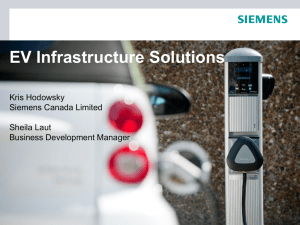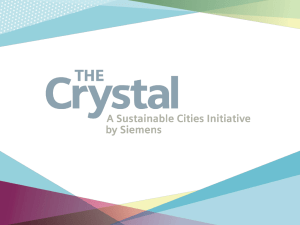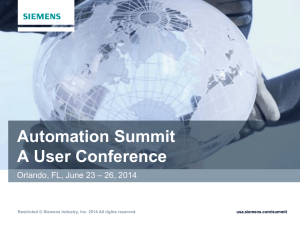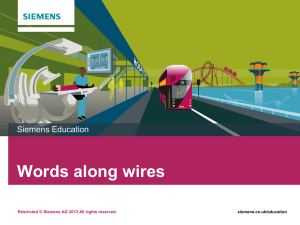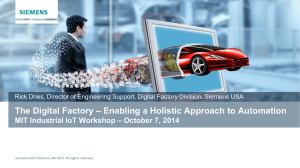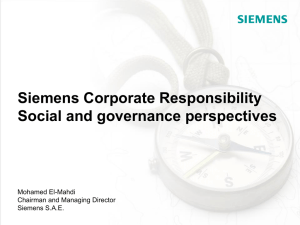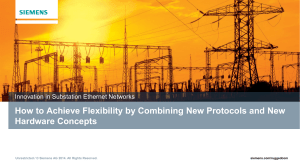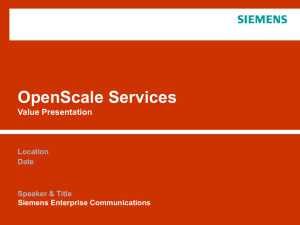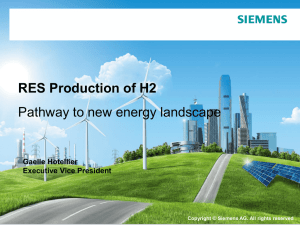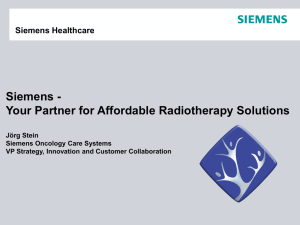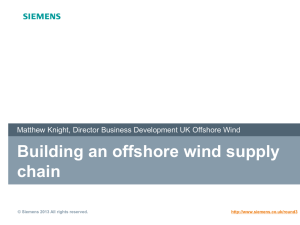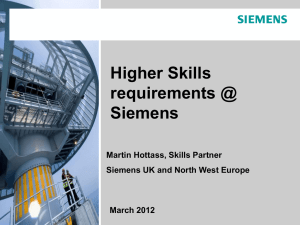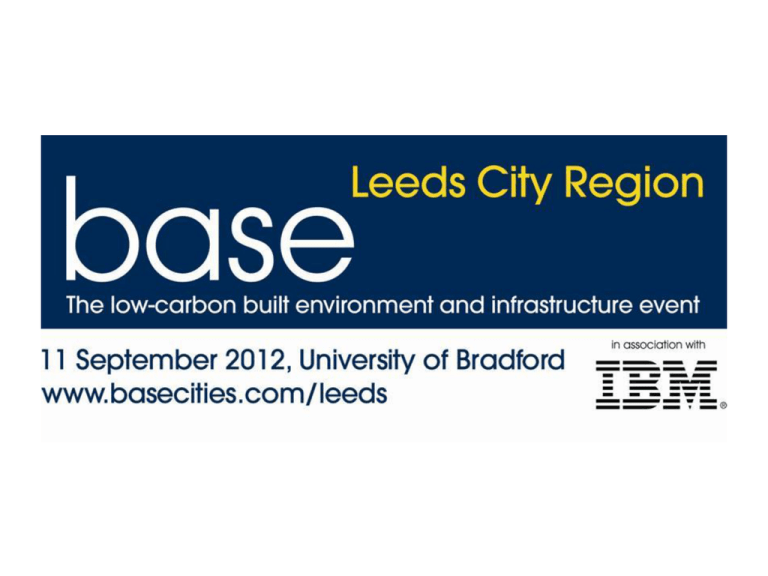
SMART CITIES: The role of ITC in
creating a low-carbon city region
economy
Andrew Carter, deputy chief executive, Centre for Cities
(chair)
Steve Peel, business development executive, Global
Technology Solutions, IBM
Hayley Dunlop, UK and Ireland smart grid director, GE
Julie Alexander, director of urban development, Siemens
Colin Blackburn, Leeds City Region Secretariat
Tom Bridges, chief economic development officer, Leeds
Bradford Future Cities
The role of ICT in creating a low
carbon economy
Julie Alexander
Siemens
Base Leeds
University of Bradford, 11th September 2012
© Siemens AG 2011. All rights reserved.
Megatrends and Sustainable Urban Development
Megatrends
Sustainable Urban Development
Globalization & Urbanization
Global players / trade volume increase
2030: 60% of population in cities
High density living demands for new
patterns in infrastructure
Demographic Change
65+ generation will nearly double
by 2030 (from 7% to 12%)
Need for adequate infrastructures
as well as health- and elder care
Climate Change
Cities responsible for ~80% GHG
Need for resource efficiency
and environmental care
|4|
Cities are competing globally
to make their urban areas
attractive to live and to invest in
Competitiveness
Governance
Quality
Environment
of Life
Challenge to balance between
competitiveness, environment
and quality of life, and to finance
infrastructure solutions
Achieve committed CO2 targets
© Siemens AG 2011. All rights reserved.
Siemens insights into "how to become sustainable",
jointly developed with major world cities
Perception
studies
Megacity Challenges
Comprehensive analysis based on interviews with
over 500 city managers in 25 selected megacities
Urban infrastructure trends and challenges as well
as global best practices
Commissioned research to GlobScan and MRCMH
Other studies: The Sustainable Cities Challenge in Canada,
ICT for City Management
Comparative
studies
Green City Index (commissioned research to EIU)
Index compares cities across 8 dimensions of
sustainability: CO2, Energy, Buildings, Transport,
Waste & Land Use, Water, Air, Governance
Europe, Africa, North / South America, Asia, Germany
Deep-Dives in infrastructure, e.g. Complete Mobility Index
Implementation
studies
|5|
Sustainable urban infrastructure series
"How to become a sustainable city" with focus on
measures for resource efficiency and CO2 abatement
Examples: Dublin, London, Munich, Yekaterinburg,
Trondheim, ...
© Siemens AG 2011. All rights reserved.
Cities need pioneering solutions to solve their
problems
How to get enough electric power, …
how to bring enough goods into the city?
How to manage the ever increasing
traffic?
How to reduce the energy consumption
… and emissions?
How to ensure security and safety
of people?
How to finance all this?
From closed island solutions and single products to
cross-linked intelligent infrastructure solutions
|6|
© Siemens AG 2011. All rights reserved.
Cities have various options to improve
energy efficiency, eco-friendliness and quality of life
Energy
Transportation
Power Generation & Distribution
High-speed train
Smart applications
Smart Grid
HVDC1)
E-mobility
Traffic Mgmt
Alt. drive system
Renewable
Building,Lighting&Security
Water & Waste
Smart and efficient buildings
Waste, Water and Wastewater Mgmt
Health
Efficient lighting
Safety Center
Medical Technology Green Hospitals
1) High Voltage Direct Current
|7|
© Siemens AG 2011. All rights reserved.
Helping cities manage and control information
City Cockpit
|8|
© Siemens AG 2011. All rights reserved.
Helping Cities Define KPIs
Green action plan
Green management
Public participation in green policy
Nitrogen dioxide
Sulphur dioxide
Ozone
Particulate matter
Air quality policies
Water consumption
Water leakages
Waste water treatment
Water efficiency
and treatment policies
Green
governance
CO2 intensity
CO2 emissions
CO2 reduction strategy
CO22
CO
Energy
Energy
Air
EGCI
Municipal waste production
Waste reduction policies
Green land use policies
Buildings
Water
Waste &
land use
Transport
Energy consumption
Energy intensity
Renewable energy consumption
Clean and efficient energy policies
Energy consumption of
residential buildings
Energy efficient buildings standards
Energy efficient buildings initiatives
Use of non-car transport
Size of non-car transport network
Green transport promotion
Congestion reduction policies
Set priorities of measures through identification of categories with performance below average
1) A research project conducted by the Economist Intelligence Unit, sponsored by Siemens
|9|
© Siemens AG 2011. All rights reserved.
Helping Cities Define KPIs
Green action plan
Green management
Public participation in green policy
Nitrogen dioxide
Sulphur dioxide
Ozone
Particulate matter
Air quality policies
Water consumption
Water leakages
Waste water treatment
Water efficiency
and treatment policies
Green
governance
CO2 intensity
CO2 emissions
CO2 reduction strategy
CO22
CO
Energy
Energy
Air
EGCI
Municipal waste production
Waste reduction policies
Green land use policies
Buildings
Water
Waste &
land use
Transport
Energy consumption
Energy intensity
Renewable energy consumption
Clean and efficient energy policies
Energy consumption of
residential buildings
Energy efficient buildings standards
Energy efficient buildings initiatives
Use of non-car transport
Size of non-car transport network
Green transport promotion
Congestion reduction policies
Set priorities of measures through identification of categories with performance below average
1) A research project conducted by the Economist Intelligence Unit, sponsored by Siemens
| 10 |
© Siemens AG 2011. All rights reserved.
Surveillance allows real time monitoring
| 11 |
© Siemens AG 2011. All rights reserved.
| 12 |
© Siemens AG 2011. All rights reserved.
Mobile parking payments
| 13 |
© Siemens AG 2011. All rights reserved.
Registering on a central system
| 14 |
© Siemens AG 2011. All rights reserved.
Sustainable Green Growth –
Siemens examples for energy efficiency in the city
Existing technology achieves high gains in efficiency and CO2 abatement
Renewables
Wind turbines:
Efficiency up from
1 MW to 6 MW
(gearless)
CO2-free energy
to the city
Example HVDC:
China 800 kV,
6.4 GW, 2,000 km
Building
technologies
30% less energy used
through building
energy management
Traffic management
system
Traffic speed: +37%
Commuter times cut
by 17%
SIPLINK
12 tons less CO2 emissions per ship and day
by local grid connection
Efficient energy
production
Combined Cycle:
From 50% to 60%
Steam Power Plant:
From 40% to 47%
High-voltage urban
link
Efficient energy
transport by HV close
to the consumer
Industry
40% less energy
consumption with
variable-speed drives
Complete Mobility
Higher attractiveness
of public transport
(reduced waiting and
up to 20% fuel savings)
Street lighting
Potential in Europe:
3.5 million tons less
CO2 emissions with
LED systems
| 15 |
© Siemens AG 2011. All rights reserved.
Sustainable Transport Networks
Efficient:
Informed
No contingency plan
Reliable:
On time
2 Hrs late
Connected:
Multi-modal
No connections
Affordable
??
£150 inc taxi
| 16 |
© Siemens AG 2011. All rights reserved.
Central data log in real time
| 17 |
© Siemens AG 2011. All rights reserved.
What’s your vision for your city of the future?
| 18 |
© Siemens AG 2011. All rights reserved.
Thank you!
Julie.Alexander@Siemens.com
The Crystal
| 19 |
© Siemens AG 2011. All rights reserved.
LCR BASE ‘Smart Cities’ Session
ENABLING THE DIGITAL
INFRASTRUCTURE FOR THE FUTURE
Colin Blackburn
Digital Infrastructure & Broadband Lead
11 September 2012
www.leedscityregion.gov.uk
Outline
• LCR Digital Framework
• Delivery Activity
– Digital Infrastructure
– Adoption and Exploitation
– Public Service Delivery
• Opportunities and Engagement
22
• Insert the rocket
24
25
Leeds City Region Digital
Infrastructure Plan
May 2012
26
LCR Digital Priorities
Priority 1:
Competitive
Digital
Infrastructure
Priority 2:
Digital
Services By
Default
Priority 4
Targeted
Exploitation
For Impact
Priority 3:
Adoption For
All
Digital Infrastructure Provision
Existing Broadband Speeds in West Yorkshire
• 90% superfast
broadband by 2015
• At least 2mbs elsewhere
• Demand stimulation &
business support
– SMEs
– LCR Priority Sectors
incl. manufacturing, &
low carbon ind’s
– Residents
• Fastrack highways &
planning processes
28
Bradford-Leeds Super Connected Cities
• Ultrafast broadband
incl. Enterprise Zone
• Free wireless Leeds &
Bradford City Centres
• Corridor Wireless
• Telehealth projects’
roll-out
Enabling the Digital Infrastructure
of the Future
• Significant economic impact, jobs and how we live
• Challenge is significant – aim high
• Infrastructure and demand stimulation
• Increasing competitiveness and innovation vital
• Significant ongoing investment and business
support essential
• Complementary roles for both public and
private sectors
…chug along or grasp the ‘Bullet’?
LCR BASE ‘Smart Cities’ Session
ENABLING THE DIGITAL
INFRASTRUCTURE FOR THE
FUTURE
Colin Blackburn
Digital Infrastructure &
Broadband Lead
11 September 2012
www.leedscityregion.gov.uk

